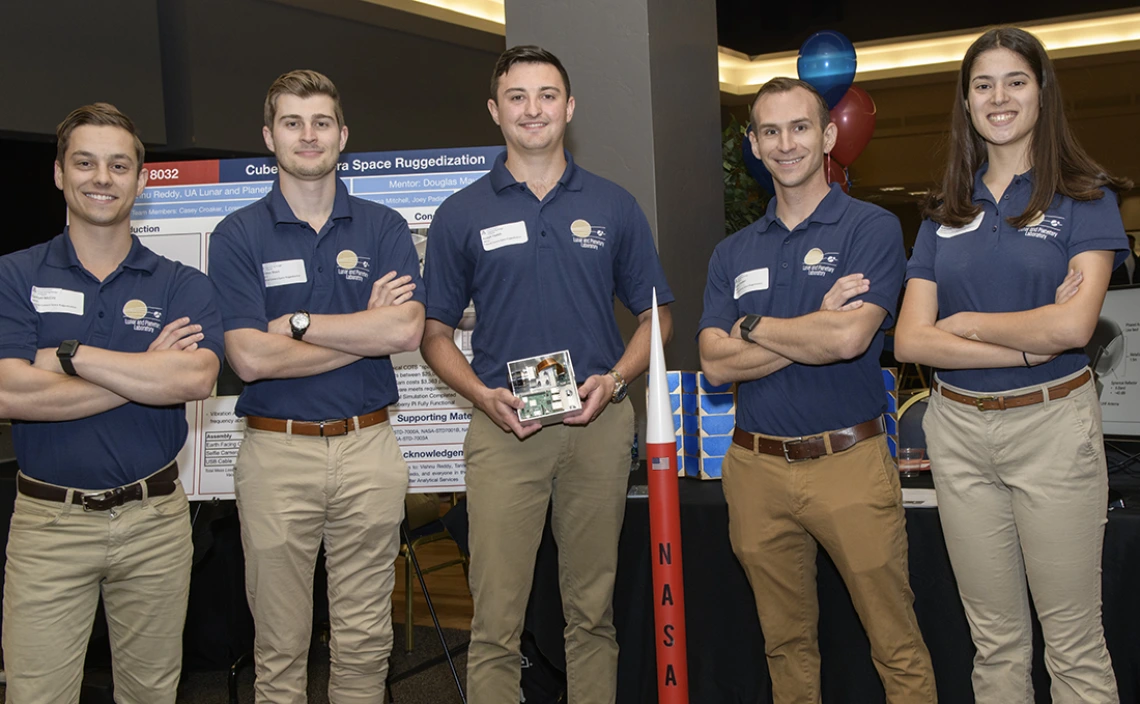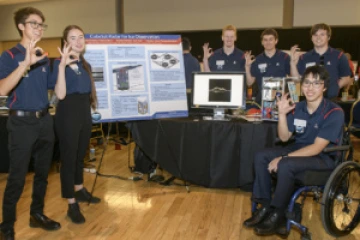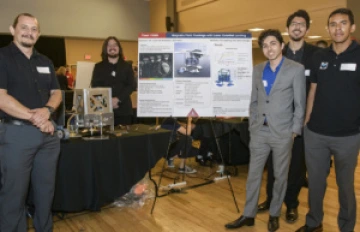Mission Accomplished: Little CubeSats Paying Off in Big Ways

NASA selected the low-cost space-qualified camera built by Team 18032 to fly aboard a future space mission as part of the agency’s CubeSat Launch Initiative.
Six 2018-2019 senior design teams aiming to advance space exploration worked on miniature satellites for collecting and relaying data. One CubeSat was selected for a NASA mission, others have moon landings in their sights, and still others are outfitted for studying climate change on Earth.
CubeSats are made up of 10-centimeter cubic units and typically weigh less than 3 pounds. Think so small you can hold it in your hand, like a tissue box, or carry easily, like an empty briefcase. These inexpensive satellites were first used about 20 years ago by students learning to design and build spacecraft for low-Earth orbit. They can be launched for about $40,000 as opposed to the millions of dollars most satellites cost.
These days ride-along CubeSats are deployed from larger space vehicles, sometimes for interplanetary missions.
“CubeSats are kind of revolutionizing space exploration right now,” said optical sciences and engineering senior Maggie Yvonne Kautz.
Making Off-the-Shelf Cameras Space Ready
Team 18032, sponsored by the UA Lunar and Planetary Laboratory, built a low-cost, space-qualified camera, which was selected to fly as auxiliary payload aboard a future space mission as part of NASA’s CubeSat Launch Initiative.
Traditional space-qualified cameras cost up to $100,000 and are not suitable for nanosatellites. So, the team used a commercial camera with a novel inflatable antenna to demonstrate transmitting video back to Earth.
Team members included Casey Adam Croaker, electrical and computer engineering and systems engineering double major; Lorenzo Dova and Rishikesh Mallela, mechanical engineering; Samuel Scot McCoy and Joe Padish, aerospace engineering; and Adriana Mitchell, optical sciences and engineering.
“We ruggedized it, space qualified it and got the cost down to $3,363,” said Padish. “That was something we were never able to do in classes — design something that would actually be machined for practical use. It was exciting to see how it all came together.”
Autonomously Capturing Images of Star Groups

Team 18088 created a CubeSat to orbit Earth and capture, store and send back images of groups of stars. The adaptable design allows companies to insert their own optical systems into the satellite.

GEOST sponsored the team, which included Fernando Coronado, mechanical engineering; Adam Humeres, aerospace and mechanical engineering; Maggie Yvonne Kautz, optical sciences and engineering; Joel Harrison Thibault, electrical and computer engineering; and Andrew Martin, engineering management.
“I was really interested in how we could miniaturize satellites and use them to explore space and get out there little by little,” said Humeres.
Affordably Researching Glacial Thickness

Current research on the thickness of glaciers is often done using radar, but gathering this data from the surface or the air above the glaciers is time-consuming and costly. So Team 18095 created a CubeSat with a radar and camera to capture data about glaciers from low Earth polar orbit.
The system includes four lightweight inflatable antennas and a simple deployment mechanism.
The UA Department of Aerospace and Mechanical Engineering sponsored the team of aerospace engineers: Anthony Nicholas Delmonti, Samuel Scot McCoy, Joe Padish, Alejandro Daniel Salgado, Xavier S. Tapia, Zhenyang Xiao and Neil Ernest Patterson.
Detecting Ice to Understand Climate Change

Using mostly off-the-shelf components, Team 18096 designed a CubeSat infrastructure to support a radar instrument for imaging the size and depth of ice sheets on Earth. CubeSats with the size of antenna they needed didn’t exist, so the team created a larger one by reverse engineering similar designs.
Aerospace engineering majors Caelan Caudell, Yusuke Ishii, Dakota Mathez, Scott Norrix, Jessica Marie Reilly and Alex McCarthy were on the team sponsored by their home department.
“Scientists can use that info to combat problems like climate change,” said McCarthy, adding, “The project was a really big challenge — no one had ever told us how to design a CubeSat before.”
Outfitting Satellite for Lunar Data Collection

The Lunar and Planetary Laboratory also sponsored a team of aerospace engineers — Brandon Daniel Burnett, Victor Emmanuel Padilla, Anthony James Riley, Jesse Christopher Samitas Chavarria and Miguel Angel Donayre — to develop a fully autonomous CubeSat capable of landing on the moon and collecting magnetic field data.
Team 18099’s design included a navigation system, camera, two solar panel arrays to convert sunlight into energy, four engines and two onboard computers.
“We really tried to challenge ourselves,” said Padilla. “Seeing the fruits of our labor come to life is the best.”
Exploring the Surface of the Moon

Another group of aerospace engineering majors sponsored by their home department — Ben Christy, Garrett Andrew Kay, Luis Rosano, Adam Ross, Bryan Patrick Schwartzman and Chandon Jaymes Lines — created a CubeSat to explore the lunar surface.
CubeSats aren’t normally designed to land, so to fit the landing gear into the device, Team 18100 built it out of a nitinol shape memory alloy, which expands when exposed to solar radiation.
“It’s basically like a big jack-in-the-box,” said Schwartzman.
The team also designed a hollow drill bit to collect and store a 10-gram sample, so there’s no need for a separate carrying container.
“We got to decide exactly where we wanted to go and what we wanted to study,” said Lines. “It was super cool to develop the mission ourselves.”

